The Impact of Trans-Atlantic Slave Trading: Historical Data Analysis
VerifiedAdded on 2022/08/20
|6
|1063
|17
Report
AI Summary
This report examines the impact of the Trans-Atlantic Slave Trade on the American experience, utilizing historical data from slavevoyages.org. The analysis focuses on voyages originating from Mainland North America, specifically Newport and Rhode Island, during the early 1800s. The report investigates mortality rates, comparing voyages from different ports and highlighting the impact of the US and British government's ban on slave importing. Data from 1800 and the subsequent decade reveals trends in slave embarkation, disembarkation, and mortality, particularly the surge in domestic slave trading following the import ban. The report concludes by emphasizing the varied mortality rates and the shift in slave trade patterns due to legislative changes. The student has gathered data and conducted analysis, and the report is available on Desklib, a platform providing AI-based study tools and past papers for students.
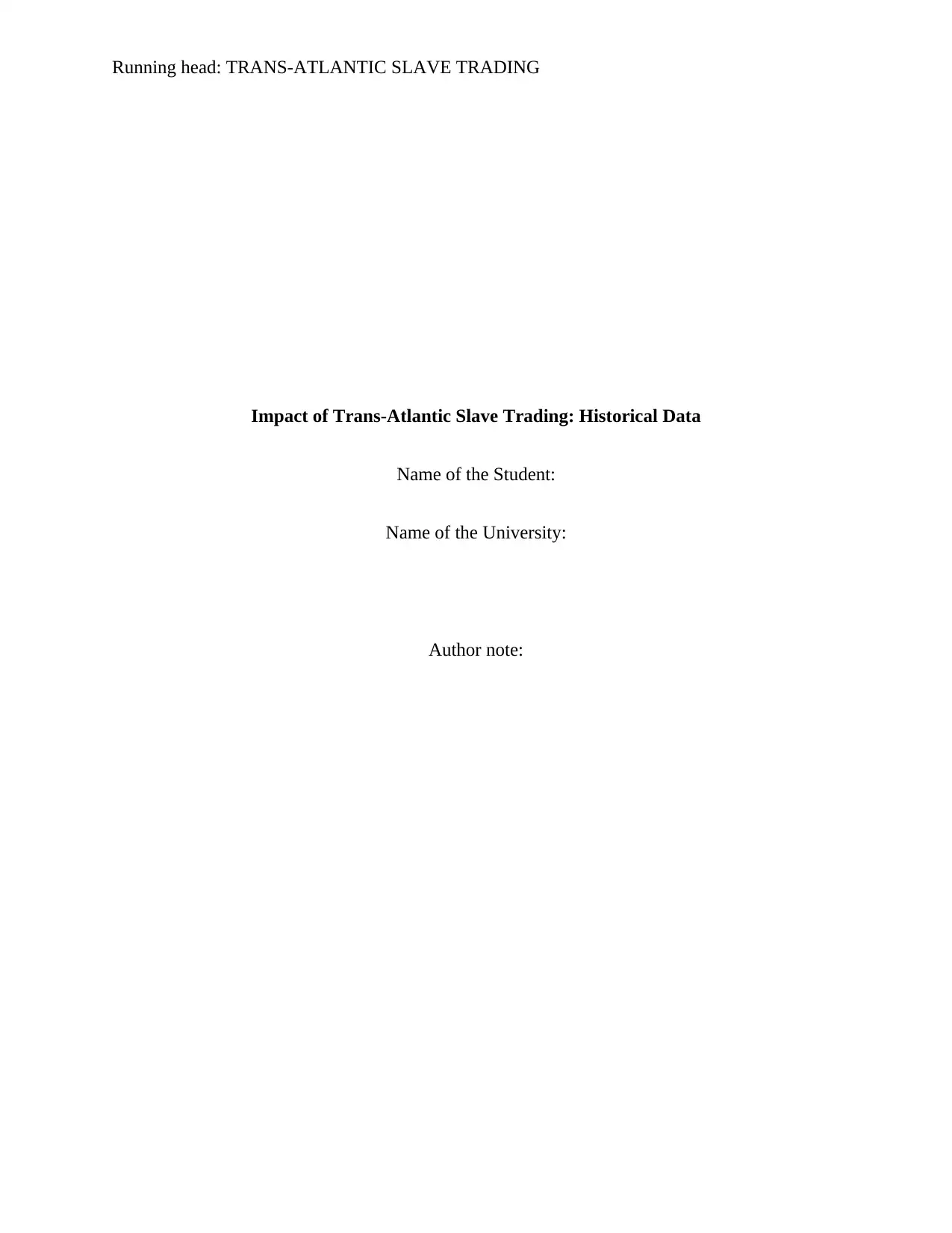
Running head: TRANS-ATLANTIC SLAVE TRADING
Impact of Trans-Atlantic Slave Trading: Historical Data
Name of the Student:
Name of the University:
Author note:
Impact of Trans-Atlantic Slave Trading: Historical Data
Name of the Student:
Name of the University:
Author note:
Paraphrase This Document
Need a fresh take? Get an instant paraphrase of this document with our AI Paraphraser
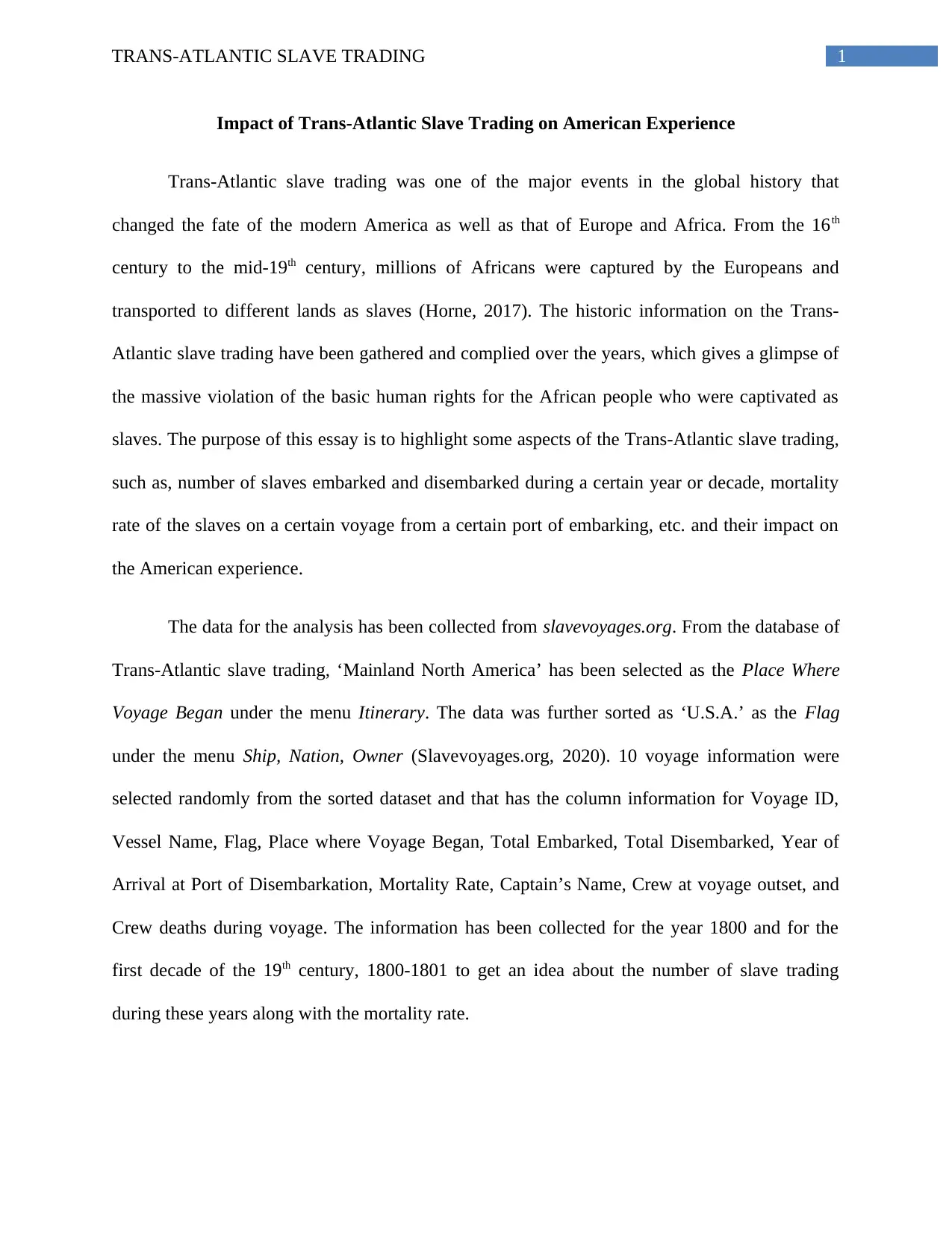
1TRANS-ATLANTIC SLAVE TRADING
Impact of Trans-Atlantic Slave Trading on American Experience
Trans-Atlantic slave trading was one of the major events in the global history that
changed the fate of the modern America as well as that of Europe and Africa. From the 16th
century to the mid-19th century, millions of Africans were captured by the Europeans and
transported to different lands as slaves (Horne, 2017). The historic information on the Trans-
Atlantic slave trading have been gathered and complied over the years, which gives a glimpse of
the massive violation of the basic human rights for the African people who were captivated as
slaves. The purpose of this essay is to highlight some aspects of the Trans-Atlantic slave trading,
such as, number of slaves embarked and disembarked during a certain year or decade, mortality
rate of the slaves on a certain voyage from a certain port of embarking, etc. and their impact on
the American experience.
The data for the analysis has been collected from slavevoyages.org. From the database of
Trans-Atlantic slave trading, ‘Mainland North America’ has been selected as the Place Where
Voyage Began under the menu Itinerary. The data was further sorted as ‘U.S.A.’ as the Flag
under the menu Ship, Nation, Owner (Slavevoyages.org, 2020). 10 voyage information were
selected randomly from the sorted dataset and that has the column information for Voyage ID,
Vessel Name, Flag, Place where Voyage Began, Total Embarked, Total Disembarked, Year of
Arrival at Port of Disembarkation, Mortality Rate, Captain’s Name, Crew at voyage outset, and
Crew deaths during voyage. The information has been collected for the year 1800 and for the
first decade of the 19th century, 1800-1801 to get an idea about the number of slave trading
during these years along with the mortality rate.
Impact of Trans-Atlantic Slave Trading on American Experience
Trans-Atlantic slave trading was one of the major events in the global history that
changed the fate of the modern America as well as that of Europe and Africa. From the 16th
century to the mid-19th century, millions of Africans were captured by the Europeans and
transported to different lands as slaves (Horne, 2017). The historic information on the Trans-
Atlantic slave trading have been gathered and complied over the years, which gives a glimpse of
the massive violation of the basic human rights for the African people who were captivated as
slaves. The purpose of this essay is to highlight some aspects of the Trans-Atlantic slave trading,
such as, number of slaves embarked and disembarked during a certain year or decade, mortality
rate of the slaves on a certain voyage from a certain port of embarking, etc. and their impact on
the American experience.
The data for the analysis has been collected from slavevoyages.org. From the database of
Trans-Atlantic slave trading, ‘Mainland North America’ has been selected as the Place Where
Voyage Began under the menu Itinerary. The data was further sorted as ‘U.S.A.’ as the Flag
under the menu Ship, Nation, Owner (Slavevoyages.org, 2020). 10 voyage information were
selected randomly from the sorted dataset and that has the column information for Voyage ID,
Vessel Name, Flag, Place where Voyage Began, Total Embarked, Total Disembarked, Year of
Arrival at Port of Disembarkation, Mortality Rate, Captain’s Name, Crew at voyage outset, and
Crew deaths during voyage. The information has been collected for the year 1800 and for the
first decade of the 19th century, 1800-1801 to get an idea about the number of slave trading
during these years along with the mortality rate.
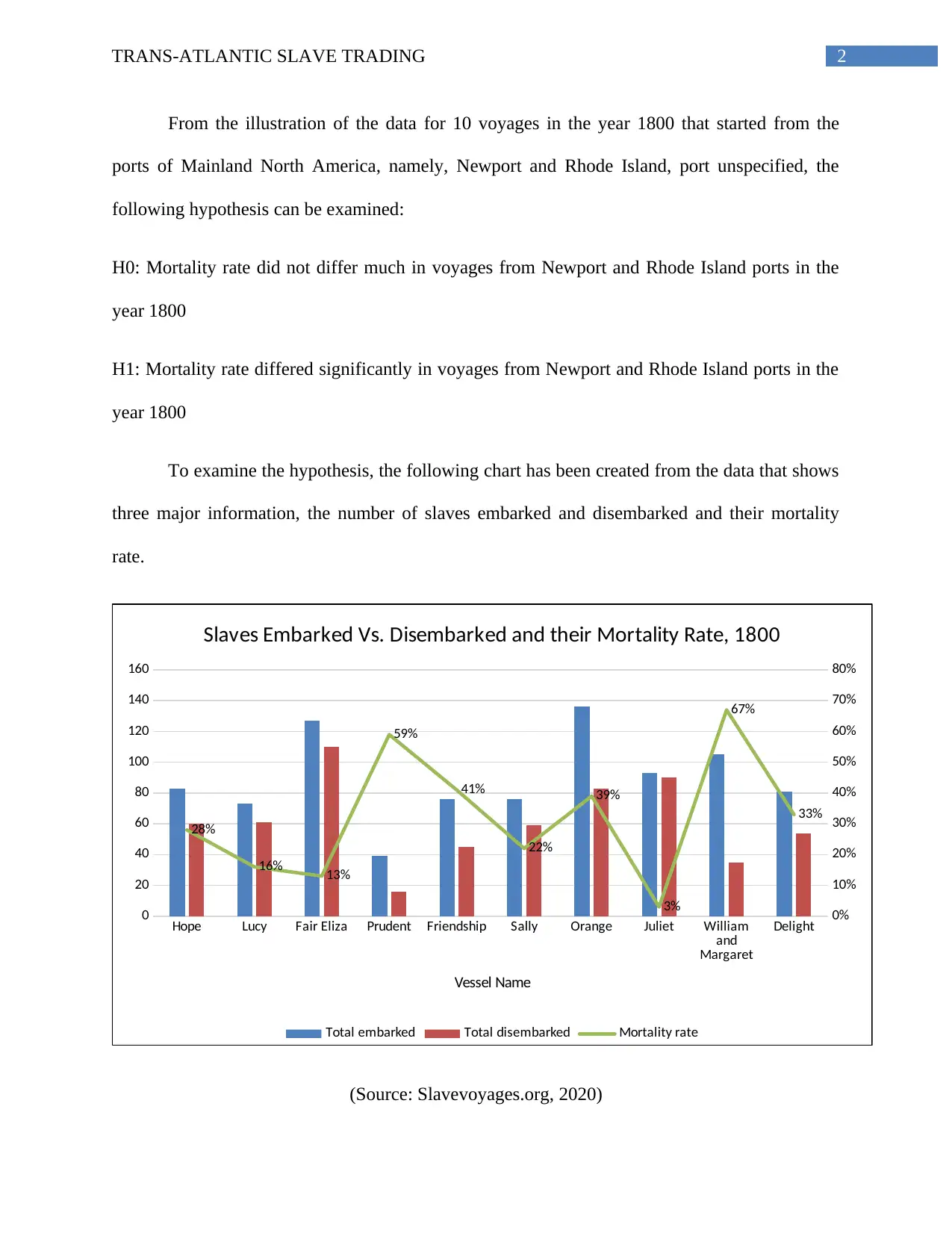
2TRANS-ATLANTIC SLAVE TRADING
From the illustration of the data for 10 voyages in the year 1800 that started from the
ports of Mainland North America, namely, Newport and Rhode Island, port unspecified, the
following hypothesis can be examined:
H0: Mortality rate did not differ much in voyages from Newport and Rhode Island ports in the
year 1800
H1: Mortality rate differed significantly in voyages from Newport and Rhode Island ports in the
year 1800
To examine the hypothesis, the following chart has been created from the data that shows
three major information, the number of slaves embarked and disembarked and their mortality
rate.
Hope Lucy Fair Eliza Prudent Friendship Sally Orange Juliet William
and
Margaret
Delight
0
20
40
60
80
100
120
140
160
0%
10%
20%
30%
40%
50%
60%
70%
80%
28%
16% 13%
59%
41%
22%
39%
3%
67%
33%
Slaves Embarked Vs. Disembarked and their Mortality Rate, 1800
Total embarked Total disembarked Mortality rate
Vessel Name
(Source: Slavevoyages.org, 2020)
From the illustration of the data for 10 voyages in the year 1800 that started from the
ports of Mainland North America, namely, Newport and Rhode Island, port unspecified, the
following hypothesis can be examined:
H0: Mortality rate did not differ much in voyages from Newport and Rhode Island ports in the
year 1800
H1: Mortality rate differed significantly in voyages from Newport and Rhode Island ports in the
year 1800
To examine the hypothesis, the following chart has been created from the data that shows
three major information, the number of slaves embarked and disembarked and their mortality
rate.
Hope Lucy Fair Eliza Prudent Friendship Sally Orange Juliet William
and
Margaret
Delight
0
20
40
60
80
100
120
140
160
0%
10%
20%
30%
40%
50%
60%
70%
80%
28%
16% 13%
59%
41%
22%
39%
3%
67%
33%
Slaves Embarked Vs. Disembarked and their Mortality Rate, 1800
Total embarked Total disembarked Mortality rate
Vessel Name
(Source: Slavevoyages.org, 2020)
⊘ This is a preview!⊘
Do you want full access?
Subscribe today to unlock all pages.

Trusted by 1+ million students worldwide
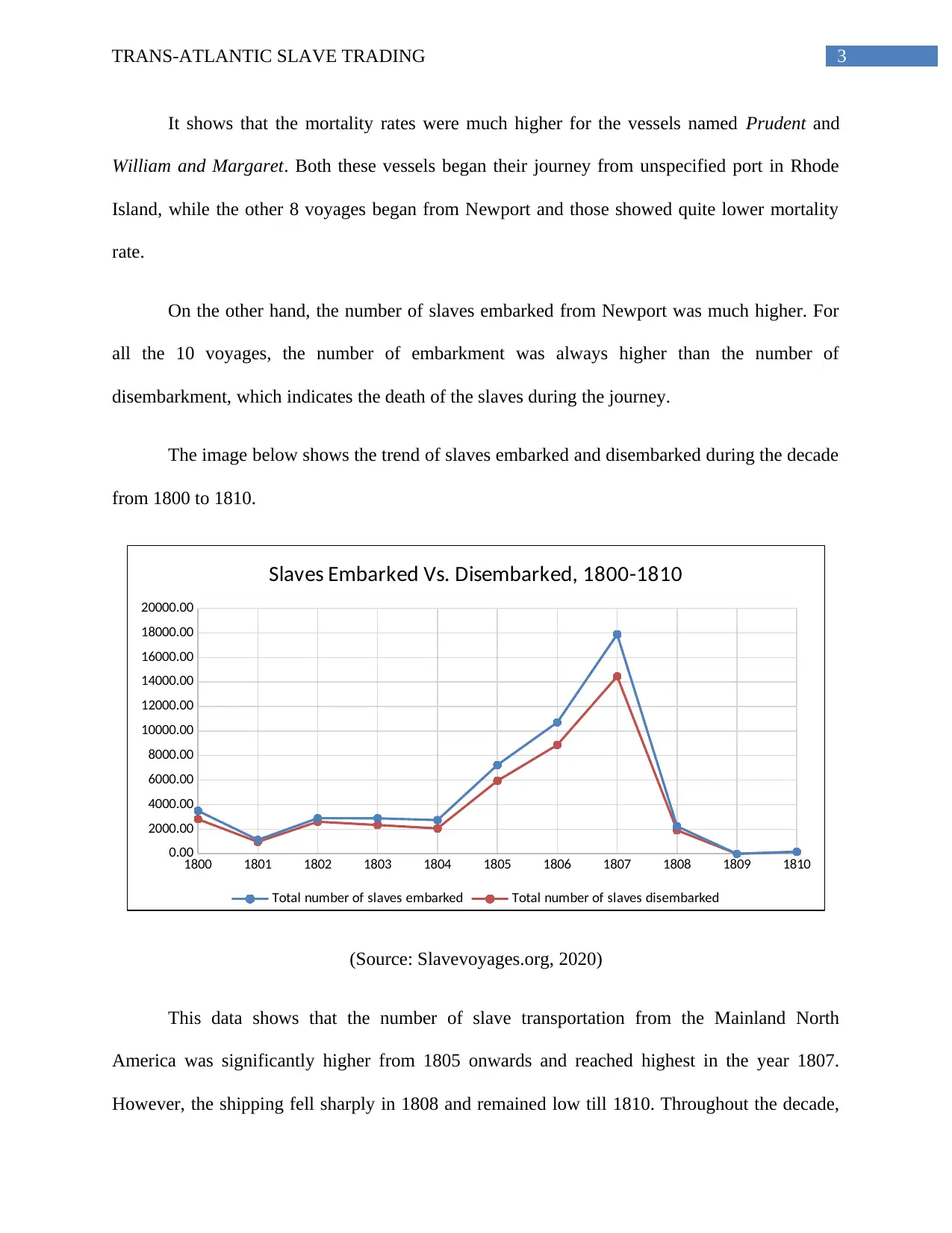
3TRANS-ATLANTIC SLAVE TRADING
It shows that the mortality rates were much higher for the vessels named Prudent and
William and Margaret. Both these vessels began their journey from unspecified port in Rhode
Island, while the other 8 voyages began from Newport and those showed quite lower mortality
rate.
On the other hand, the number of slaves embarked from Newport was much higher. For
all the 10 voyages, the number of embarkment was always higher than the number of
disembarkment, which indicates the death of the slaves during the journey.
The image below shows the trend of slaves embarked and disembarked during the decade
from 1800 to 1810.
1800 1801 1802 1803 1804 1805 1806 1807 1808 1809 1810
0.00
2000.00
4000.00
6000.00
8000.00
10000.00
12000.00
14000.00
16000.00
18000.00
20000.00
Slaves Embarked Vs. Disembarked, 1800-1810
Total number of slaves embarked Total number of slaves disembarked
(Source: Slavevoyages.org, 2020)
This data shows that the number of slave transportation from the Mainland North
America was significantly higher from 1805 onwards and reached highest in the year 1807.
However, the shipping fell sharply in 1808 and remained low till 1810. Throughout the decade,
It shows that the mortality rates were much higher for the vessels named Prudent and
William and Margaret. Both these vessels began their journey from unspecified port in Rhode
Island, while the other 8 voyages began from Newport and those showed quite lower mortality
rate.
On the other hand, the number of slaves embarked from Newport was much higher. For
all the 10 voyages, the number of embarkment was always higher than the number of
disembarkment, which indicates the death of the slaves during the journey.
The image below shows the trend of slaves embarked and disembarked during the decade
from 1800 to 1810.
1800 1801 1802 1803 1804 1805 1806 1807 1808 1809 1810
0.00
2000.00
4000.00
6000.00
8000.00
10000.00
12000.00
14000.00
16000.00
18000.00
20000.00
Slaves Embarked Vs. Disembarked, 1800-1810
Total number of slaves embarked Total number of slaves disembarked
(Source: Slavevoyages.org, 2020)
This data shows that the number of slave transportation from the Mainland North
America was significantly higher from 1805 onwards and reached highest in the year 1807.
However, the shipping fell sharply in 1808 and remained low till 1810. Throughout the decade,
Paraphrase This Document
Need a fresh take? Get an instant paraphrase of this document with our AI Paraphraser
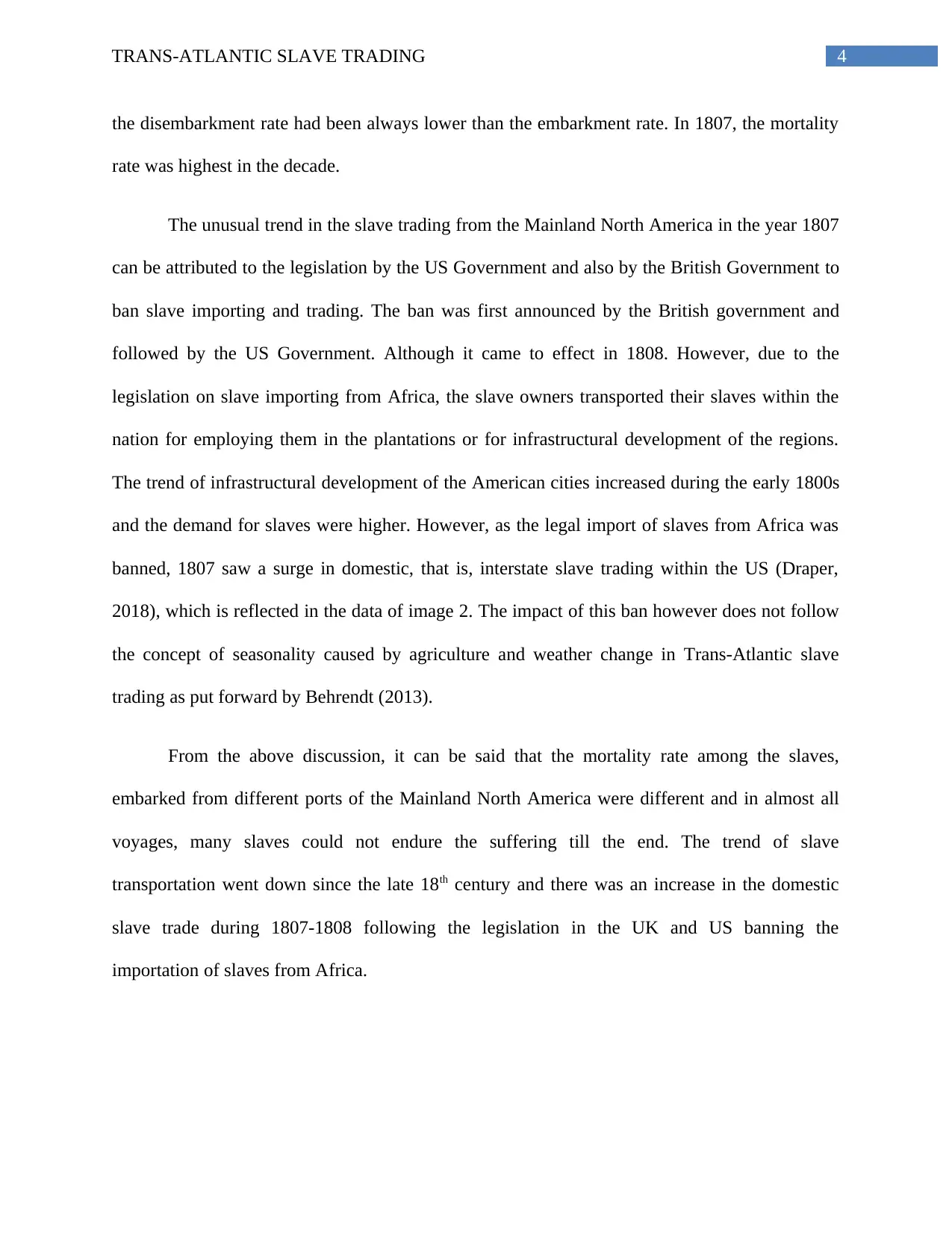
4TRANS-ATLANTIC SLAVE TRADING
the disembarkment rate had been always lower than the embarkment rate. In 1807, the mortality
rate was highest in the decade.
The unusual trend in the slave trading from the Mainland North America in the year 1807
can be attributed to the legislation by the US Government and also by the British Government to
ban slave importing and trading. The ban was first announced by the British government and
followed by the US Government. Although it came to effect in 1808. However, due to the
legislation on slave importing from Africa, the slave owners transported their slaves within the
nation for employing them in the plantations or for infrastructural development of the regions.
The trend of infrastructural development of the American cities increased during the early 1800s
and the demand for slaves were higher. However, as the legal import of slaves from Africa was
banned, 1807 saw a surge in domestic, that is, interstate slave trading within the US (Draper,
2018), which is reflected in the data of image 2. The impact of this ban however does not follow
the concept of seasonality caused by agriculture and weather change in Trans-Atlantic slave
trading as put forward by Behrendt (2013).
From the above discussion, it can be said that the mortality rate among the slaves,
embarked from different ports of the Mainland North America were different and in almost all
voyages, many slaves could not endure the suffering till the end. The trend of slave
transportation went down since the late 18th century and there was an increase in the domestic
slave trade during 1807-1808 following the legislation in the UK and US banning the
importation of slaves from Africa.
the disembarkment rate had been always lower than the embarkment rate. In 1807, the mortality
rate was highest in the decade.
The unusual trend in the slave trading from the Mainland North America in the year 1807
can be attributed to the legislation by the US Government and also by the British Government to
ban slave importing and trading. The ban was first announced by the British government and
followed by the US Government. Although it came to effect in 1808. However, due to the
legislation on slave importing from Africa, the slave owners transported their slaves within the
nation for employing them in the plantations or for infrastructural development of the regions.
The trend of infrastructural development of the American cities increased during the early 1800s
and the demand for slaves were higher. However, as the legal import of slaves from Africa was
banned, 1807 saw a surge in domestic, that is, interstate slave trading within the US (Draper,
2018), which is reflected in the data of image 2. The impact of this ban however does not follow
the concept of seasonality caused by agriculture and weather change in Trans-Atlantic slave
trading as put forward by Behrendt (2013).
From the above discussion, it can be said that the mortality rate among the slaves,
embarked from different ports of the Mainland North America were different and in almost all
voyages, many slaves could not endure the suffering till the end. The trend of slave
transportation went down since the late 18th century and there was an increase in the domestic
slave trade during 1807-1808 following the legislation in the UK and US banning the
importation of slaves from Africa.
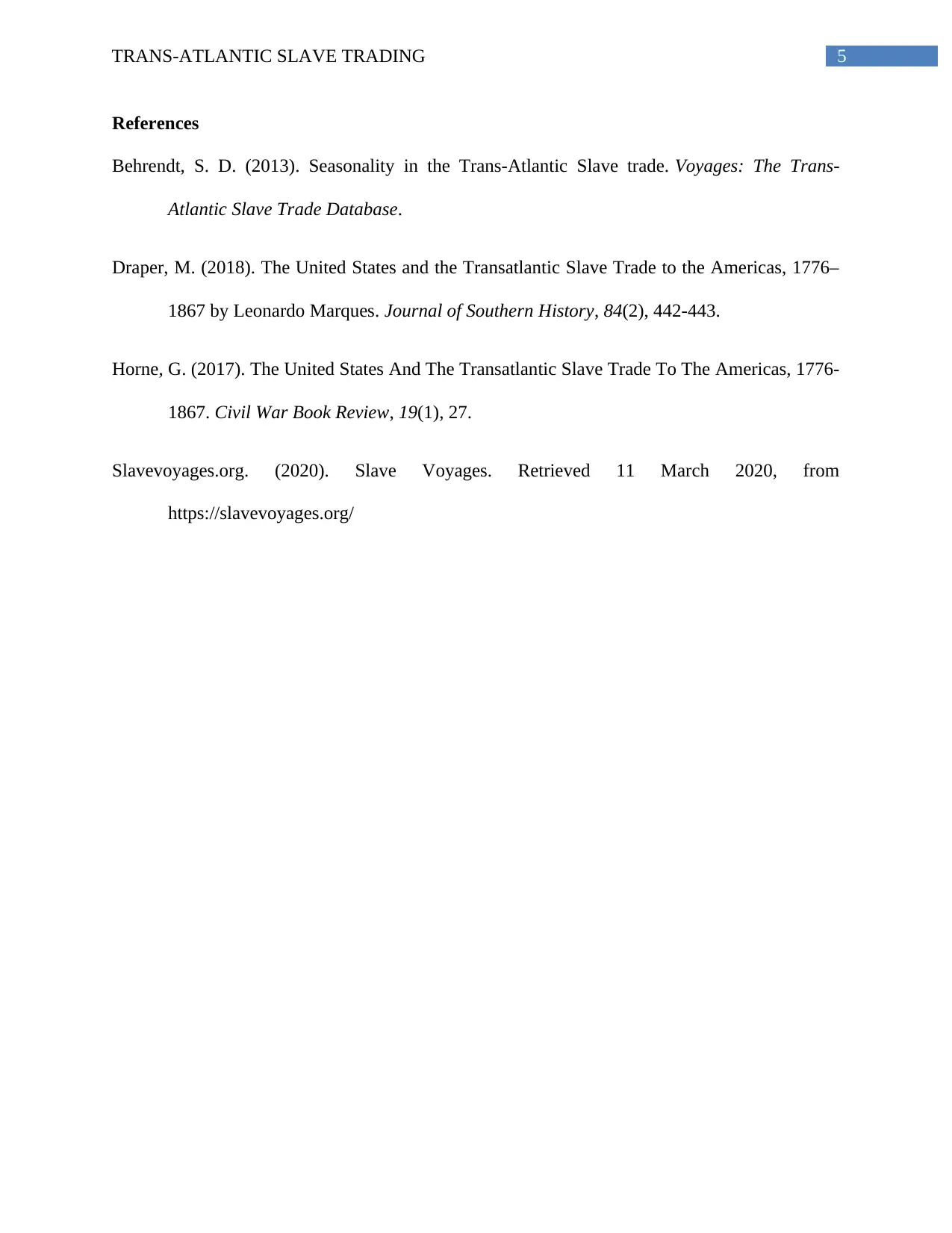
5TRANS-ATLANTIC SLAVE TRADING
References
Behrendt, S. D. (2013). Seasonality in the Trans-Atlantic Slave trade. Voyages: The Trans-
Atlantic Slave Trade Database.
Draper, M. (2018). The United States and the Transatlantic Slave Trade to the Americas, 1776–
1867 by Leonardo Marques. Journal of Southern History, 84(2), 442-443.
Horne, G. (2017). The United States And The Transatlantic Slave Trade To The Americas, 1776-
1867. Civil War Book Review, 19(1), 27.
Slavevoyages.org. (2020). Slave Voyages. Retrieved 11 March 2020, from
https://slavevoyages.org/
References
Behrendt, S. D. (2013). Seasonality in the Trans-Atlantic Slave trade. Voyages: The Trans-
Atlantic Slave Trade Database.
Draper, M. (2018). The United States and the Transatlantic Slave Trade to the Americas, 1776–
1867 by Leonardo Marques. Journal of Southern History, 84(2), 442-443.
Horne, G. (2017). The United States And The Transatlantic Slave Trade To The Americas, 1776-
1867. Civil War Book Review, 19(1), 27.
Slavevoyages.org. (2020). Slave Voyages. Retrieved 11 March 2020, from
https://slavevoyages.org/
⊘ This is a preview!⊘
Do you want full access?
Subscribe today to unlock all pages.

Trusted by 1+ million students worldwide
1 out of 6
Your All-in-One AI-Powered Toolkit for Academic Success.
+13062052269
info@desklib.com
Available 24*7 on WhatsApp / Email
![[object Object]](/_next/static/media/star-bottom.7253800d.svg)
Unlock your academic potential
Copyright © 2020–2025 A2Z Services. All Rights Reserved. Developed and managed by ZUCOL.